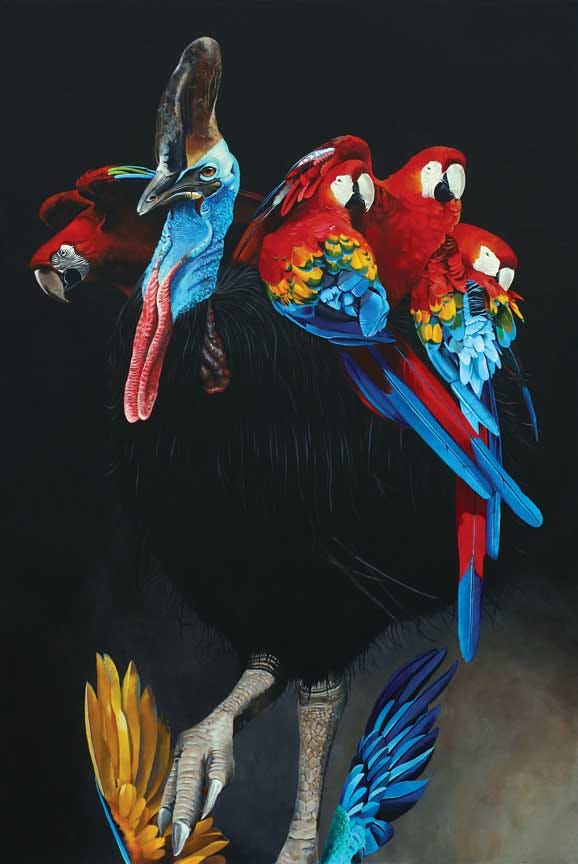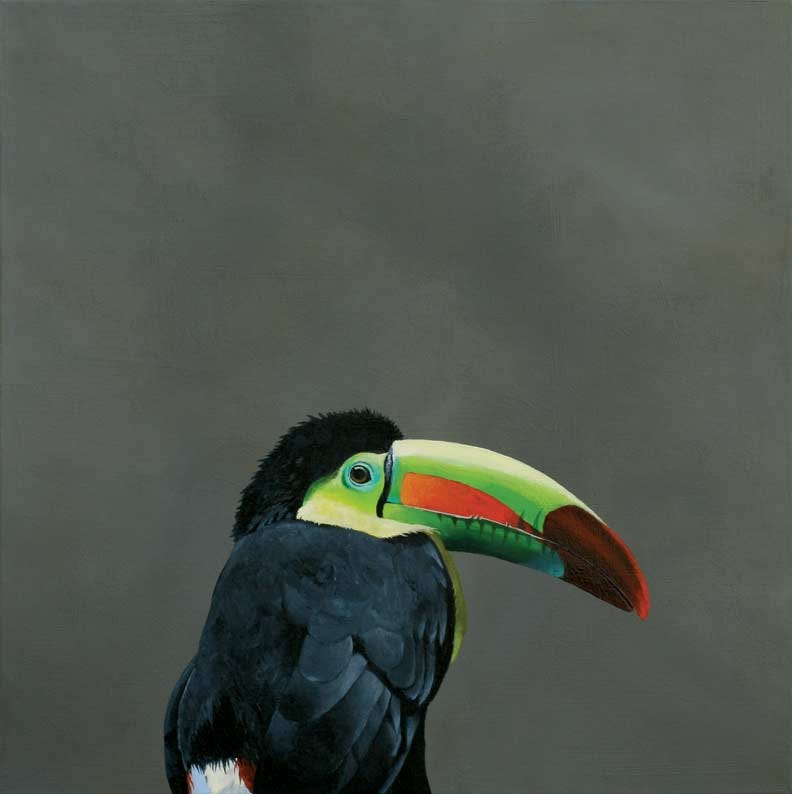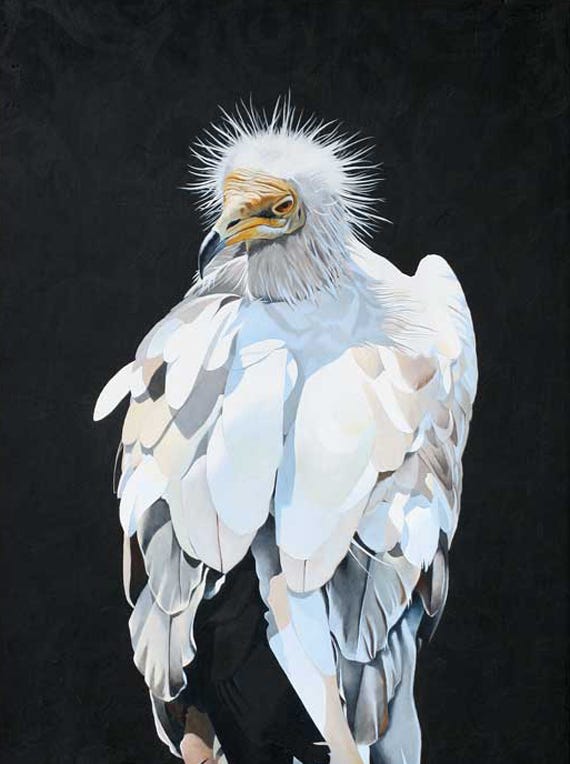By Jordan Schaul | National Geographic | August 5, 2013
Have you heard of the book entitled The Birds of North America by James John Audubon? One highly coveted copy was auctioned off in March of 2000 to Qatar’s Sheikh Saud bin Muhammed Al Thani for 8.8 million dollars. The amount seems pretty pricy for any book, let alone one about the feathered and typically flighted.

However, The Birds of North America is perhaps, the most important and most renowned of contributions to nature writing and illustration for any natural history publication to date.
Audubon was not only a preeminent naturalist, but a very distinguished painter and the book may very well warrant a steep sales price! I recently discovered Mr. Audubon has some competition when it comes to painting birds, however, and from right here in Southern California.
I stepped into a gallery on Ventura Boulevard near Studio City the other day and was blown away by a painting of a cassowary, and the, perhaps, peculiar placement of several macaws on the back of the flightless bird. The painting jumped out at me because, I’m very wary of cassowaries, number one, and number two, the attention to detail rendered the image so real, it was unbelievable.
So I introduce some of the bird paintings of Matt Adrian with their accompanying titles, which have been collected in two volumes: “IT IS FOLLY TO ASSUME MY AWESOME LIES DORMANT: The Paintings of The Mincing Mockingbird” and “I HAVE HEARD MY PRAISES SUNG IN SCREAMS: The Paintings of The Mincing Mockingbird Volume II”.
Interview:
Jordan Schaul: I saw several of your bird paintings, but can you describe the scope of what’s in your portfolio?
Matt Adrian: My work ranges from the delightfully cute to the decidedly sinister, much like nature itself.”
Jordan Schaul: Can you elaborate on the titles?
Matt Adrian: The titles add a dimension to the artwork and are sometimes as important as what’s on the canvas The titles of the paintings sometimes comment on what is pictured, and sometimes the titles are non-sequiturs, and sometimes they deal directly with man’s impact on nature, something that very much underpins my work. The contrast between the more frivolous aspects of modern daily life placed against the very real destruction not only of habitat but of beautiful, irreplaceable creatures is something I’m always exploring.
Jordan Schaul: Can you tell me a bit about your interest in bird conservation?
Matt Adrian: Bird conservation is extremely important to me. Currently, I have a show of paintings up (“Pelagic Paintings”) at the Audubon’s Project Puffin Visitor Center in Rockland, Maine. Half of the proceeds of painting sales go toward this important program. It means a lot to me to be able to use my artwork to directly help this program dedicated to restoring seabird diversity.

ABOUT NATIONAL GEOGRAPHIC SOCIETY
The National Geographic Society is a global nonprofit organization that uses the power of science, exploration, education and storytelling to illuminate and protect the wonder of our world. Since 1888, National Geographic has pushed the boundaries of exploration, investing in bold people and transformative ideas, providing more than 14,000 grants for work across all seven continents, reaching 3 million students each year through education offerings, and engaging audiences around the globe through signature experiences, stories and content. To learn more, visit www.nationalgeographic.org or follow us on Instagram, Twitter and Facebook.
MEET THE AUTHOR
Jordan Carlton SchaulWith training in wildlife ecology, conservation medicine, and comparative psychology, Dr. Schaul's contributions to Nat Geo Voices have covered a range of environmental and social topics. He draws particular attention to the plight of imperiled species highlighting issues at the juncture or nexus of sorta situ wildlife conservation and applied animal welfare. Sorta situ conservation practices are comprised of scientific management and stewardship of animal populations ex situ (in captivity / 'in human care') and in situ (free-ranging / 'in nature'). He also has a background in behavior management and training of companion animals and captive wildlife and conservation marketing and digital publicity. Jordan has shared interviews with colleagues and public figures, as well as editorial news content. In addition, he has posted narratives describing his own work, which include the following examples: • Restoration of wood bison to the Interior of Alaska (As Animal Curator at Alaska Wildlife Conservation Center and courtesy professor at the University of Alaska) • Rehabilitation of orphaned sloth bears exploited for tourists in South Asia (As executive consultant 'in-residence' at the Agra Bear Rescue Center managed by Wildlife SOS) • Censusing small wild cat (e.g. ocelot and margay) populations in the montane cloud forests of Costa Rica for popular publications with 'The Cat Whisperer' Mieshelle Nagelschneider • Evaluating the impact of ecotourism on marine mammal population stability and welfare off the coast of Mexico's Sea of Cortez (With Boston University's marine science program) Jordan was a director on boards of non-profit wildlife conservation organizations serving nations in Africa, North and South America and Southeast Asia. He is also a consultant to a human-wildlife conflict mitigation organization in the Pacific Northwest. Following animal curatorships in Alaska and California, he served as a charter board member of a zoo advocacy and outreach organization and later as its executive director. Jordan was a member of the Communication and Education Commission of the International Union for the Conservation of Nature (CEC-IUCN) and the Bear Specialist Group of the IUCN Species Survival Commission (BSG-SSC-IUCN). He has served on the advisory council of the National Wildlife Humane Society and in service to the Bear Taxon Advisory Group of the Association of Zoos and Aquariums (AZA Bear TAG). In addition, he was an ex officio member of the council of the International Association for Bear Research and Management.



